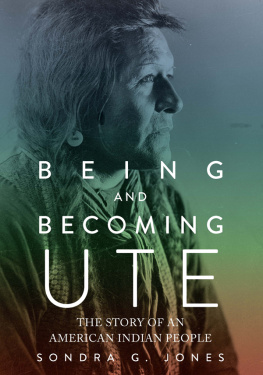Sondra G Jones - Being and Becoming Ute
Here you can read online Sondra G Jones - Being and Becoming Ute full text of the book (entire story) in english for free. Download pdf and epub, get meaning, cover and reviews about this ebook. publisher: University of Utah Press, genre: Politics. Description of the work, (preface) as well as reviews are available. Best literature library LitArk.com created for fans of good reading and offers a wide selection of genres:
Romance novel
Science fiction
Adventure
Detective
Science
History
Home and family
Prose
Art
Politics
Computer
Non-fiction
Religion
Business
Children
Humor
Choose a favorite category and find really read worthwhile books. Enjoy immersion in the world of imagination, feel the emotions of the characters or learn something new for yourself, make an fascinating discovery.
- Book:Being and Becoming Ute
- Author:
- Publisher:University of Utah Press
- Genre:
- Rating:3 / 5
- Favourites:Add to favourites
- Your mark:
- 60
- 1
- 2
- 3
- 4
- 5
Being and Becoming Ute: summary, description and annotation
We offer to read an annotation, description, summary or preface (depends on what the author of the book "Being and Becoming Ute" wrote himself). If you haven't found the necessary information about the book — write in the comments, we will try to find it.
Being and Becoming Ute — read online for free the complete book (whole text) full work
Below is the text of the book, divided by pages. System saving the place of the last page read, allows you to conveniently read the book "Being and Becoming Ute" online for free, without having to search again every time where you left off. Put a bookmark, and you can go to the page where you finished reading at any time.
Font size:
Interval:
Bookmark:

ARCIA.Annual Report of the Commissioner of Indian Affairs
BIA. Bureau of Indian Affairs
BOR. U.S. Bureau of Reclamation
BYC. Brigham Young Collection, located in the Historical Archives of The Church of Jesus Christ of Latter-day Saints, Salt Lake City, Utah
BYMH. Brigham Young, Manuscript History, located in the Historical Archives of The Church of Jesus Christ of Latter-day Saints, Salt Lake City, Utah
BYU-HBLL. Brigham Young University, Harold B. Lee Library
BYU-SC. Brigham Young University, Harold B. Lee Library, Special Collections & Americana
CHC.Comprehensive History of the Church, by B. H. Roberts (1930), 6 vols.
CHL. Church History Library, The Church of Jesus Christ of Latter-day Saints, Salt Lake City, Utah
DOI. U.S. Department of the Interior
DUP. Daughters of Utah Pioneers
GAS. George A. Smith Collection
JD.Journal of Discourses, Located in the Historical Archives of The Church of Jesus Christ of Latter-day Saints, Salt Lake City, Utah
JH.Journal History, located in the Historical Archives of The Church of Jesus Christ of Latter-day Saints, and on microfilm
MANM. Mexican Archives of New Mexico (microfilm), located in New Mexico State Historical Archives, Santa Fe, New Mexico
OCSC. Omer C. Stewart Collection, Norlin Library, University of Colorado, Boulder
OIA. Office of Indian Affairs, Letters Received. Microfilm. RG 75, M-234
OIA-UT. Office of Indian Affairs, Letters Received, 18241881, Utah Superintendency, 18491880. National Archives Record Group. RG 75, M-234, rolls 897898
RSI.Report of the Secretary of the Interior
TANM. Territorial Archives of New Mexico (microfilm), Located in New Mexico State Historical Archives, Santa Fe, New Mexico
USHS. Utah State Historical Society Archives, Salt Lake City, Utah
USIA. Utah Superintendency of Indian Affairs, Letters to the Office of Indian Affairs
UTMC. Utah Territorial Military Correspondence (microfilm). Located in the Utah Historical Society Archives
WR. War of the Rebellion, U.S. Department of War, A Compilation of the Official Records of the Union and Confederate Armies (1897)
Historical Nomenclature for Ute Bands
Modern Ute bands (and tribes) exist today as political entities because Euro-Americans needed to have distinguishing names for Ute groups for economic and administrative purposes. Early explorers did identify the local Indian groups they encountered and recorded these in diaries, memoirs, and reports. But by the 1850s, officially identifying these bands and tribes became politically important for the purpose of negotiating treaties or agreements with specific people with identifiable leaders in order to administer affairs through Indian agencies, and later reorganized corporate tribal organizations. However, traditional Ute bands were fluid, geosocial units. Although they were usually based on kin-and-clique relationships (family and friends), members couldand often didshift allegiance and territory for a variety of reasons. Nevertheless, the nucleus of band membership usually remained relatively stable, as did the traditional nomadic circuit through which they traveled.
Because of the often amorphous nature of Ute bands, names and terms used for them are not always consistent in the historical and ethnographic literature. As a result, identifying exactly which group a record referred to can be problematic. In this study I have attempted to use the most easily identifiable references from the scholarly literature while still remaining as true as possible to traditional native identities. Since some of the names or origins of names may need more clarification than is possible within the text or notes of this book, the following list identifies most Ute bands, their names, and where they were usually located (within the constraints of seasonal nomadism). The list has been compiled from major historical, ethnographic, and native sources, and in some cases includes explanatory notes. It includes both native terms and those used by non-Indians, with differences often being little more than dialect and spelling variations, as non-Indians attempted to record unfamiliar words and names.
THE PEOPLE
The People or The Real People is the English translation of the term(s) Numic people used to refer to themselves. Variations include:
Nu-ci, Nutc, or the suffixes -nuch, -wach, meaning The People or the people of (Opler 1940; Southern Ute Dictionary 1979; Powell 1971)
Nooche, Nuche, or Noochew (tribal websites and resources)
Nu-ints, nuints, nuau, or the suffix nunts, meaning an Indian (Powell 1971; Stewart 1942, 1952)
Num, Numa, Nuum-pats, or Numic People, meaning an Indian or nuum-pats, meaning one who speaks Ute (Powell 1971)
Non-Indian names for Utes include:
Yutas, Yuttas, Yutaas, Youta (Escalante, and Chavez and Warner 1776/1995; Miera Map; Powell 1971; Fowler and Fowler citing Zarate Salmeron [1620s]; Stewart 1973; Tyler 1951; Ruxton 1950; Talbot 1931; Rivera, Leiby 1985). Spanish name, meaning and origin unknown.
Qusutus or Guaputa (Tyler 1951)
Eut, Ewte, Eutau, Eutaw, Eutah (Ferris 1940; Ruxton 1916, 1950; Brewerton 1993; Anderson 1967; Russell 1965; Yount 1966; O. Huntington, n.d.; Hafen and Hafen 1954)
Utacas, Utas, Utahs, or Utah Indians (J. Smith 1972; Potts letters 18241827; Hamilton 1960; Sage 1857; ARCIA; Journal History; Treaty 1849; Heap 1857; Gottfredson 1969; Scholes 1936; Stewart 1973) This spelling was used into the 1860s.
Ute became the predominate name after 1859, e.g., ARCIA (1856): Utah Indians (commonly called Utes).
Note: Eutah Lake, Utas Lake, Utaw Lake and Utaw Mountains, Utah Lake, and Utah Valley (e.g., Potts letters 2000; Fremont 1966; J. Smith 1972; Russell 1965; Journal History; O. Huntington, n.d.)
WHITE RIVER UTES
Todays White River Utes are an amalgamation of Ute bands who ranged through northwestern Colorado, particularly along the Yampa, White, andGrand Rivers, and were federally administered at the White River Indian Agency. They were frequent visitors at Denver and the Denver subagency so were sometimes referred to as Denver Utes. Today the amalgamated White Rivers are one of three bands on the Uintah and Ouray Reservation. (Identified in contemporary government documents, e.g., Agreement 1880 and Removal Act 1880; ARCIA; Powell 1971; Stewart 1942, 1952; current tribal website.)
White River Utes (band)
Taviwadziu, Taviwatsiu, Tav-i-wot-su (Stewart 1942, 1952; Powell 1971; Lowie 1924). Described as those formerly west of Denver, and that Denver was center of Taviwatsiu area; some have confused this band with Escalantes Tabehuachis.
Parianuche or Parianuc, Parusanuch. From west central Colorado, pah- or pa- meaning water or river.
Yampa Utes
By 1800 this band had moved into the Yampa River Valley, an area that had been vacated by Escalantes Yamparika Comanches. Yampa Utes occasionally crossed the Uintah Basin to visit central Utah. Yamparkau means Yampa eaters, a favorite tuberous food (Perideridia gairdneri) that grew plentifully in this region. Utes called the river Yam-pa-pa (river where yampa grows).
Yam-pa Kau-ru-ats, Yamparkau, Yamparka, Yamparika, Yamparica (Powell 1971; Stewart 1942; Escalante, and Chavez and Warner, 1976/1995)
Yampa, Yampah, Yampai, Yampus, Yampaats, Jimpipas (Irish, Report on Spanish Fork Council; Treaties 1868, Agreement 1873; Powell 1971; Stewart 1952)
Font size:
Interval:
Bookmark:
Similar books «Being and Becoming Ute»
Look at similar books to Being and Becoming Ute. We have selected literature similar in name and meaning in the hope of providing readers with more options to find new, interesting, not yet read works.
Discussion, reviews of the book Being and Becoming Ute and just readers' own opinions. Leave your comments, write what you think about the work, its meaning or the main characters. Specify what exactly you liked and what you didn't like, and why you think so.











